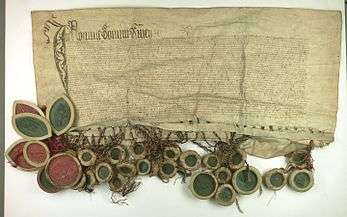Znamensk, Kaliningrad Oblast
Znamensk (Russian: ![]()
![]()

History
The site of today's Znamensk was originally an Old Prussian fort, with a settlement named Velowe nearby. The site featured an unusually large oak tree, considered sacred by the local Prussians.[4] It survived at least until 1595, when it was mentioned by Caspar Hennenberger.[4]
Around 1255 the locality was fortified, but the castle was surrendered to the Teutonic Knights by its mayor, Tirslo. The Teutons continued to use the castle and began to colonize the region with Germans, giving the settlement the name Wehlau. It received its civic charter in 1335 and in 1339 and became a centre for horse stables and horse trade.[4] Until the late 19th century the town was allowed to organise a six-day linen fair, a three-day horse fair and two additional horse and cattle fairs every year.[4] In 1349 Grand Master of the Teutonic Order Heinrich Dusemer founded a Franciscan Monastery there to commemorate his victory over the Prussians in the battle of Streba River.[4] In 1380 the St. Jacob's church was erected.
In 1454, during the Thirteen Years' War, the castle and the city joined the Kingdom of Poland.[4] However, in 1460 the Teutonic Order besieged the town and successfully retook it.[4] In 1490 Grand Master Johann von Tiefen restored (or founded, the sources are unclear) another Franciscan monastery in the town. However, it was destroyed in 1519 in the course of Protestant Reformation, when the burghers converted to Protestantism and decided that such a small town is not able to bear the burden of sustaining two monasteries.[4]

In 1540 the town was destroyed by a large fire and only the St. Jacob's church was left standing. Wehlau was successfully rebuilt, although natural disasters struck it repeatedly, notably in 1542 and 1593.[4] The town finally recovered and by the end of 16th century Margrave Georg Friedrich considered moving the University of Königsberg to Wehlau, which however never materialised.[4] In the Treaty of Wehlau signed in the town in 1657, Frederick William, Elector of Brandenburg, received sovereignty over the Duchy of Prussia.[4]
In 1818, it became the seat of Landkreis Wehlau in East Prussia within the Kingdom of Prussia. In 1871 Wehlau joined the German Empire. By the end of the 19th century the town had roughly 4000 inhabitants, mostly German Lutherans.[4] The town had a station of the Prussian Eastern Railway connecting Königsberg and Berlin to the Saint Petersburg–Warsaw Railway, as well as a Lutheran church, a regional courthouse and a school.[4]
Near the end of World War II, in 23 January 1945, the town was taken by the Soviet Red Army. The old town center was almost completely destroyed, and the German population fled during the evacuation of East Prussia or expelled. It became part of the Kaliningrad Oblast and was renamed Znamensk, losing its civic rights in the process. It was demoted to a rural settlement in 2006.
Notable people
- George von Kunheim (1523–1611) married Margaretha Luther, grandchild of Martin Luther in 1555.
- Johann Christoph Strodtmann (1717–1756) a German author, writing on theology, philology, classical studies, history of law and history of scholarship
- Ernst Vanhöffen (1858–1918), zoologist
- David Hilbert (1862–1943), mathematician
- Walter Schütz (1897–1933), politician
- Herbert Pilch (1927–2018), linguist
References
Citations
- Russian Federal State Statistics Service (2011). "Всероссийская перепись населения 2010 года. Том 1" [2010 All-Russian Population Census, vol. 1]. Всероссийская перепись населения 2010 года [2010 All-Russia Population Census] (in Russian). Federal State Statistics Service.
- Russian Federal State Statistics Service (21 May 2004). "Численность населения России, субъектов Российской Федерации в составе федеральных округов, районов, городских поселений, сельских населённых пунктов – районных центров и сельских населённых пунктов с населением 3 тысячи и более человек" [Population of Russia, Its Federal Districts, Federal Subjects, Districts, Urban Localities, Rural Localities—Administrative Centers, and Rural Localities with Population of Over 3,000] (XLS). Всероссийская перепись населения 2002 года [All-Russia Population Census of 2002] (in Russian).
- "Всесоюзная перепись населения 1989 г. Численность наличного населения союзных и автономных республик, автономных областей и округов, краёв, областей, районов, городских поселений и сёл-райцентров" [All Union Population Census of 1989: Present Population of Union and Autonomous Republics, Autonomous Oblasts and Okrugs, Krais, Oblasts, Districts, Urban Settlements, and Villages Serving as District Administrative Centers]. Всесоюзная перепись населения 1989 года [All-Union Population Census of 1989] (in Russian). Институт демографии Национального исследовательского университета: Высшая школа экономики [Institute of Demography at the National Research University: Higher School of Economics]. 1989 – via Demoscope Weekly.
- Sulimierski et al., p. 264.
Bibliography
- (in Polish) Filip Sulimierski; et al. (1882). "Iława nad Preglem". Geographical Dictionary of the Kingdom of Poland. III (I ed.). Warsaw: Filip Sulimierski & Władysław Walewski. p. 960.